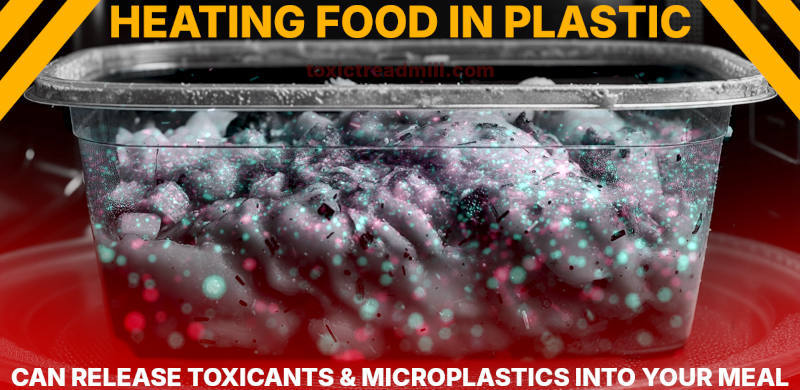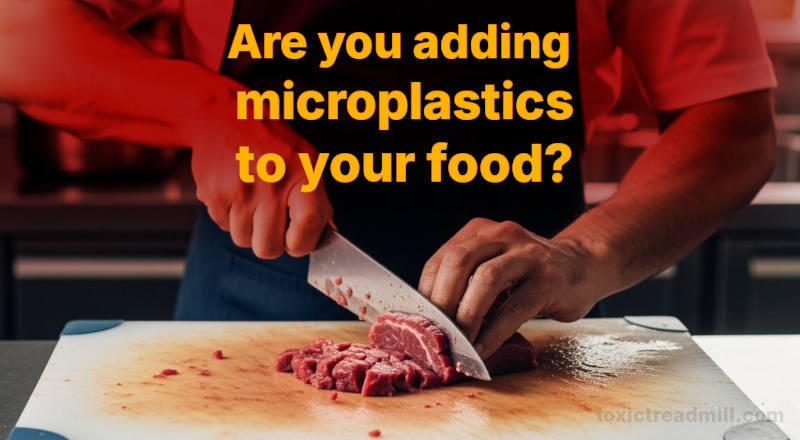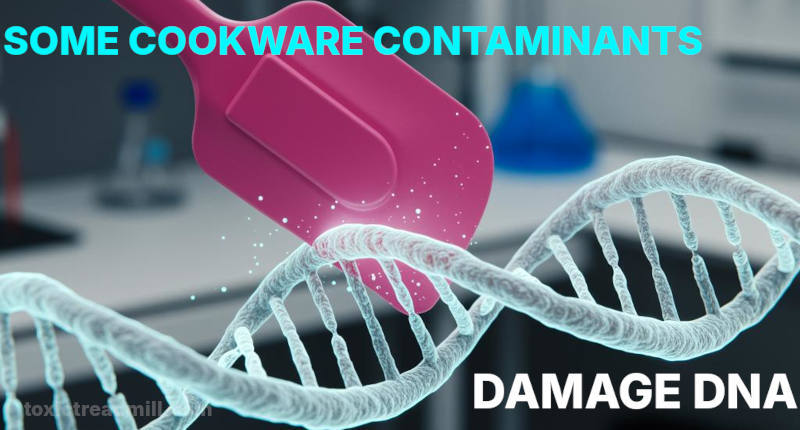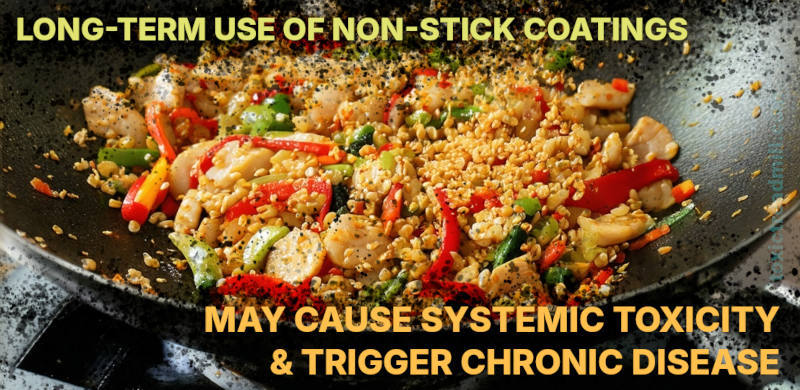Toxic Treadmill
Evidence for a Poisoned Planet
The Health Hazards of Cookware, Kitchenware, and Food Bags
Modern kitchens increasingly rely on a wide array of manufactured utensils and containers that guarantee convenience and food preservation. However, under the influence of heat, abrasion, and careless use, these kitchenware items have been shown to release toxicants that pose potential human health risks. Multiple studies have reported that chemicals and microplastics can leach into foods prepared in or stored with these products. Health harms may include triggering chronic conditions including endocrine disorders, cancers, and metabolic and neurological diseases.
Sources of Chemical Migrants in Kitchenware
Plastic Containers and Utensils
Plastics are ubiquitous components in modern kitchen environments; they are used for food storage, serving as containers, freezer bags, ice cube holders, and even as utensils such as spatulas. Many plastics inherently contain additives such as plasticizers, stabilizers, and colourants, while others may harbour residual monomers and oligomers from incomplete polymerization. Studies have demonstrated that heated plastics, particularly those not manufactured for high‐temperature stability, exhibit increased rates of migration of substances such as BPA, phthalates, and microplastics. For instance, BPA is an estrogenic chemical that has been linked to reproductive toxicity and metabolic disruptions, with documented daily intake for some demographics reaching concerning levels under routine use conditions. Elevated temperature and mechanical stress (for example, repeated microwaving or dishwashing) further accelerate degradation and migration from plastic matrices, leading to significant quantities of microplastics and nanoplastics as well as soluble toxic compounds entering the food matrix.

Non-Stick Cookware and Coated Utensils
Non-stick cookware, predominantly coated with polytetrafluoroethylene (PTFE or Teflon), is popular due to its ease of cleaning and food release properties. However, studies have documented that when PTFE-coated pans are heated above recommended temperatures or abraded by metal utensils, they can undergo thermal degradation. Under these conditions, PTFE decomposes to release a constellation of toxic gases, including perfluoroalkyl compounds (e.g., PFOA) and ultrafine PTFE particles, which present serious acute respiratory hazards as well as potential long-term systemic toxicity. Even at normal cooking temperatures below 230° C, low-level emissions of volatile and particulate substances have been detected, suggesting that chronic low-dose exposure is a relevant concern for frequent users of such cookware.
Metallic Cookware and Glazed Ceramics
Metallic kitchen implements, such as pans, cooking pots, and utensils made from stainless steel, aluminium, cast iron, or copper, can release metal ions into food during cooking. The extent of metal leaching is influenced by factors such as pH and the presence of acidic foods. For instance, aluminium and copper can leach from their respective cookware, particularly in uncoated or poor-quality products, resulting in elevated levels of metal ions that may accumulate in human tissues. While some metals like iron may be beneficial within recommended levels, chronic exposure to aluminium, nickel, or cadmium from repeated cooking can lead to systemic toxicity and has been associated with neurological disorders and renal damage. Moreover, glazed ceramics, especially if improperly manufactured, have been shown to leach lead and cadmium, thereby augmenting exposure to these potent toxins.
Silicone and Other Alternative Materials
Silicone, often marketed as a safer alternative to plastics, is used in products such as baking mats, microwaveable food containers, and ice cube trays. Nevertheless, recent studies have indicated that under certain conditions such as microwave heating, silicone food containers may release cyclic siloxanes and other low-molecular-weight compounds. Although some of these compounds have low acute toxicity, concerns remain regarding their potential for hormonal disruption and carcinogenicity, especially with prolonged and repeated use.
Mechanisms of Chemical Release
Heat-Induced Degradation and Leaching
Heat is one of the primary catalysts for the degradation of polymeric materials and the leaching of chemicals. During the cooking process and even during reheating in microwaves, the elevated temperatures cause physical and chemical breakdown of the polymer matrix. This not only generates monomers and oligomers but also facilitates the migration of additives. For example, heating of PET bottles or food containers made from polyethylene terephthalate can lead to the release of aldehydes and antimony, a heavy metal originally used as a catalyst in PET synthesis. Similarly, when non-stick coatings are overheated, PTFE undergoes pyrolysis, generating both ultrafine nanoparticles and toxic fluorocarbon gases. These processes are often exacerbated by prolonged heating, and may be further intensified in the presence of fatty or acidic food simulants that enhance diffusion and solubilization.
Abrasion and Mechanical Degradation
Mechanical wear, including abrasion caused by improper cleaning practices or the use of metal-based utensils on non-stick surfaces, significantly increases the release of chemical migrants. The physical disruption of surface coatings not only exposes the underlying polymer to further degradation but also liberates particles that have been partially detached from the material matrix. In the case of non-stick pans, for instance, abrasion induced by metal utensils can release microplastic and nanoplastic particles along with residual synthesis chemicals, further compounding the exposure to toxic substances. Similarly, repetitive mechanical stresses on plastic cutting boards and spatulas contribute to the formation and dissemination of microplastics, which can be ingested along with food.

Improper Use and Inappropriate Material Selection
The risks associated with kitchenware-mediated toxicant exposure are not confined solely to the inherent properties of the materials, but are also strongly influenced by user practices. For instance, using plastics that are not rated for microwave use (for example, heating vinyl or scraped / damaged plastic containers) can lead to significantly elevated levels of chemical migration. Additionally, the utilization of non-approved replacements for 'safer' chemicals (such as substituting BPA with other bisphenol derivatives whose toxicological profiles are not well characterized) may inadvertently increase exposure risks through similar endocrine disruption mechanisms. These irresponsible practices not only accelerate the breakdown of the materials, but also promote the leaching of both direct toxicants and compounds that may be metabolized further into harmful chemicals upon ingestion.
Biological Harms Linked to Kitchenware-Derived Toxicants
Endocrine Disruption
A significant body of evidence implicates chemicals leached from kitchenware—including BPA, phthalates, and certain oligomeric compounds—in the disruption of endocrine signalling. BPA, in particular, is well documented as an estrogen mimic that interferes with hormone balance by binding to estrogen receptors, thereby affecting reproductive development, fetal growth, and metabolic regulation. Even low doses of BPA and similar compounds can trigger nonmonotonic dose responses, complicating risk assessments based solely on concentration thresholds. Epidemiological data, coupled with in vitro mechanistic studies, have associated lifetime exposure to these endocrine-disrupting chemicals with increased incidences of reproductive disorders, reduced fertility, obesity, and even potential links to endocrine-related cancers.
Carcinogenicity and Genotoxicity
Several chemicals released from kitchenware materials possess carcinogenic and genotoxic potentials. For example, heavy metals such as lead, cadmium, nickel, and arsenic—which can leach from metallic and ceramic cookware—have been classified by various regulatory agencies as probable human carcinogens. In addition, styrene and its oligomers, which may leach from polystyrene containers under heated conditions, are suspected of contributing to carcinogenesis by generating DNA damage through reactive intermediates. The formation of toxic decomposition products in overheated PTFE cookware (including perfluoroalkyl substances, such as PFOA) is similarly concerning due to their reported role in tumorigenesis and their capacity to bioaccumulate, thereby increasing long-term cancer risk. Studies have demonstrated that conditions such as microwave heating and physical abrasion can markedly increase the release of these carcinogens, correlating with higher observed biomarkers of genotoxic stress in both in vitro and in vivo models.
Neurological and Cognitive Effects
Neurological impairments associated with chronic exposure to toxic kitchenware-derived chemicals are increasingly reported. For instance, aluminium released from uncoated cookware has been implicated in neurodegenerative conditions such as Alzheimer’s disease. Similarly, exposure to peripheral endocrine disruptors like BPA is associated with neurodevelopmental delays in children and cognitive dysfunction in adults. Mechanistic studies suggest that these compounds can cross the blood-brain barrier, induce oxidative stress and inflammatory responses in neuronal tissues, and interfere with neurotransmitter signalling. Although direct epidemiological correlations remain an area of active research, animal studies and in vitro cellular assays bolster the notion that prolonged exposure contributes to neurotoxicity and cognitive deficits.
Metabolic, Renal, and Cardiovascular Disorders
The metabolic implications of chronic exposure to chemical migrants from kitchenware materials extend to renal and cardiovascular systems. Persistent exposure to heavy metals (e.g., lead and cadmium) through routine use of metallic cookware has been linked to kidney dysfunction and hypertension. Concurrently, endocrine disruptors such as phthalates not only interfere with hormonal regulation but also have been associated with insulin resistance, obesity, and metabolic syndrome (a constellation of conditions that predispose individuals to cardiovascular disease). Microplastics released from plastic kitchenware have the ability to adsorb additional environmental contaminants. This means they may serve as vectors for complex chemical mixtures that exacerbate inflammatory processes within blood vessels, leading to atheroma formation and increased risks of myocardial infarction and stroke.
Chronic Inflammatory and Immune Modulation Effects
Ingested microplastics and chemical leachates may trigger persistent inflammatory responses. The physical presence of sub-100 nm plastic particles has been demonstrated to elicit oxidative stress in cellular models through increased reactive oxygen species generation. Chronic exposure and subsequent accumulation of these particles, along with associated chemical pollutants such as phthalates and BPA, may modulate immune responses. Disrupted immune modulation has been linked with an increased susceptibility to infections, compromised vaccine responses, and even autoimmunity. Although the direct epidemiological data remain incomplete, in vitro toxicity testing on human cell lines shows that such exposures impair normal cellular function and may ultimately lead to chronic inflammatory conditions.

Quantitative Exposure Assessments and Dose-Response Relationships
Several studies have attempted to quantify the release rates of toxicants under controlled conditions. For instance, microwave heating of plastic containers has been reported to increase the release of microplastics from hundreds of thousands to millions of particles per litre, with concomitant release of BPA and other plasticizers in measurable concentrations. Additionally, quantitative migration experiments with PET and polypropylene have documented specific limits of chemical leaching, with some studies reporting phthalate migration levels of up to 53% under accelerated conditions. In the case of PTFE-coated cookware, thermal degradation experiments have quantified PFOA emissions ranging from near-negligible levels at normal cooking temperatures to as high as 12,190 ng per hour under overheating conditions. Although these figures vary by study and experimental design, the consensus is that conditions that exceed manufacturer-recommended limits (e.g., prolonged heating, direct flame exposure, or mechanical damage) substantially increase chemical release. Such quantitative data are crucial for risk assessments and for establishing regulatory thresholds aimed at minimizing long-term exposure and mitigating chronic health risks.
Impact of Specific User Practices
Heat Stress and Microwave Use
Heating represents a primary factor in increasing migration rates of toxicants. Laboratory tests using food simulants have shown that elevated temperatures not only increase diffusion rates of additives but can also induce chemical reactions that transform parent compounds into more toxic metabolites. For example, reheating food in plastic containers or using microwave ovens with plastics not rated for high temperatures greatly increases the release of microplastics and plasticizers. Additionally, thermal conditions that mimic prolonged cooking cycles—particularly in households with frequent microwave use—underscore the potential for repeated low-dose exposure that cumulatively raises health risks.
Mechanical Abrasion and Tool Misuse
Mechanical abrasion, such as using metal utensils on non-stick pans or excessive scrubbing of containers, aggravates the degradation of protective coatings and polymer matrices. When non-stick surfaces are scratched, for example, the protective PTFE layer is compromised, which catalyses further thermal degradation and facilitates the release of both microplastic particles and chemical contaminants. Evidence suggests such use not only increases acute chemical release but also reduces the lifespan of the product, necessitating more frequent replacements and potentially increasing overall exposure rates. In plastic kitchen utensils, repeated bending, cutting, and abrasion contribute to surface wear, thereby elevating the concentration of leachable substances.

Inappropriate Material Use for Heating
Another source of risk is the inappropriate use of plastics that are not designed for high-temperature applications. Kitchen practices including heating foods in containers designed for cold storage or reusing single-use plastics in microwave applications have been linked to accelerated migration of toxicants. Similar concerns arise with polyethylene and polyvinyl chloride products that can release hazardous compounds such as styrene or antimony when exposed to conditions beyond their safe temperature ranges. Laboratory studies have quantified a significant increase in chemical leaching under these improper usage scenarios, providing a strong rationale for consumer education and stricter regulatory guidelines regarding product labelling and safe-use instructions.
Cumulative and Long-Term Health Implications
Chronic Disease Burden
The cumulative effect of repeated exposure to low doses of toxins derived from kitchenware has significant public health implications. Even if individual exposures are below acute toxicity thresholds, the aggregate effect of long-term exposure can lead to chronic conditions. Epidemiological studies (albeit with variable quantitative exposure data) have correlated prolonged ingestion of endocrine disruptors, heavy metals, and microplastics with increased incidences of chronic illnesses such as cancer, diabetes, cardiovascular disease, and neurodegenerative disorders. The underlying mechanisms involve chronic inflammation, oxidative stress, and disruption of hormonal regulation, which over time can lead to irreversible tissue damage.
Vulnerable Populations
Sensitive population groups, including infants, children, pregnant women, and the elderly, are particularly vulnerable to these toxic exposures. For example, infants exposed to microplastics through heated plastic baby bottles or food pouches face a higher risk of developmental toxicity due to both higher relative doses and the critical windows of organogenesis. Similarly, endocrine disruptors such as BPA have been implicated in reproductive and neurodevelopmental deficiencies that manifest in childhood and later life. Given the potential for transgenerational effects, heightened vigilance is warranted to limit exposure in these high-risk groups.
Bioaccumulation and Metabolic Transformation
Another area of concern is the potential for bioaccumulation of chemical migrants and their metabolites. Many chemicals leached from kitchenware, such as phthalates, BPA, and heavy metals, have long biological half-lives and can disrupt metabolic processes upon accumulation in tissues. Some compounds may also undergo metabolic conversion in the liver into more reactive species that enhance cellular toxicity or even act as pro-carcinogens. Although the precise bioaccumulation kinetics vary by compound and exposure route, the overall risk underscores the importance of cumulative dose monitoring over a lifetime.
Summary
Kitchenware items are significant sources of chemical exposure, especially plastic containers, non-stick pans, and metallic utensils. Conditions of heat, abrasion, and improper use significantly increase the hazard. Collectively, these mechanisms contribute to exposures that are quantitatively significant when considered over long periods, thereby increasing the likelihood of chronic health effects such as endocrine disruption, carcinogenesis, neurotoxicity, and metabolic disturbances.
Simple measures may help reduce the risk:
- Select kitchenware that is certified for high-temperature applications and avoid the use of plastics.
- Avoid cooking foods in plastic packaging, especially soft plastics.
- Replace non-stick cookware that shows signs of coating degradation to prevent increased particulate and chemical release.
- Use utensils made of inert materials such as high-grade stainless steel or silicone that has been properly manufactured and rigorously tested for chemical stability.
- Avoid using metal utensils and sharp-edged implements on non-stick surfaces, where they may cause abrasive damage.
- Follow manufacturer instructions regarding temperature limits.
- Use glass and ceramic (with appropriately tested glazes), for food storage and heating.
References
Alaboodi, A. S., Sivasankaran, S., & Ammar, H. R. (2024). Influence of heating temperature and time on mechanical-degradation, microstructures and corrosion performances of Teflon/granite coated aluminium alloys used for non-stick cookware. Heliyon, 10(14).
Bansal, C., Zaina, S., & Parihar, V. (2020). Review on Health Impact of Hazardous and Safest Traditional Cookware With Ayurvedic Approach. Ayushdhara, 7(1), 2559-2566.
Bridson, J. H., Gaugler, E. C., Smith, D. A., Northcott, G. L., & Gaw, S. (2021). Leaching and extraction of additives from plastic pollution to inform environmental risk: a multidisciplinary review of analytical approaches. Journal of Hazardous Materials, 414, 125571.
Gupta, R. K., Pipliya, S., Karunanithi, S., Eswaran U, G. M., Kumar, S., Mandliya, S., ... & Kovács, B. (2024). Migration of Chemical Compounds from Packaging Materials into Packaged Foods: Interaction, Mechanism, Assessment, and Regulations. Foods, 13(19), 3125.
Hussain, K. A., Romanova, S., Okur, I., Zhang, D., Kuebler, J., Huang, X., ... & Li, Y. (2023). Assessing the release of microplastics and nanoplastics from plastic containers and reusable food pouches: implications for human health. Environmental Science & Technology, 57(26), 9782-9792.
Koo, Y. J., Pack, E. C., Lee, Y. J., Kim, H. S., Jang, D. Y., Lee, S. H., ... & Choi, D. W. (2020). Determination of toxic metal release from metallic kitchen utensils and their health risks. Food and Chemical Toxicology, 145, 111651.
Muncke, J., Backhaus, T., Geueke, B., Maffini, M. V., Martin, O. V., Myers, J. P., ... & Scheringer, M. (2017). Scientific challenges in the risk assessment of food contact materials. Environmental Health Perspectives, 125(9), 095001.
Panou, A., & Karabagias, I. K. (2024). Migration and safety aspects of plastic food packaging materials: need for reconsideration?. Coatings, 14(2), 168.
Peñate, C. O. (2021). Microplastics in drinking water, food, and everyday products. Environmental Health Association of Québec (ASEQ-EHAQ).
Pizzorno, J. (2024). Plastic food container safety. Integrative Medicine: A Clinician's Journal, 23(2), 6.
Priyanka, A. (2021). Thermal Efficiency and Quality of Cooked Food: Evaluation of Cookware Materials (Doctoral dissertation, PUNJAB AGRICULTURAL UNIVERSITY LUDHIANA).
Proshad, R., Kormoker, T., Islam, M. S., Haque, M. A., Rahman, M. M., & Mithu, M. M. R. (2018). Toxic effects of plastic on human health and environment: A consequences of health risk assessment in Bangladesh. International Journal of Health, 6(1), 1-5.
Sajid, M., & Ilyas, M. (2017). PTFE-coated non-stick cookware and toxicity concerns: a perspective. Environmental Science and Pollution Research, 24, 23436-23440.
Snekkevik, V. K., Cole, M., Gomiero, A., Haave, M., Khan, F. R., & Lusher, A. L. (2024). Beyond the food on your plate: Investigating sources of microplastic contamination in home kitchens. Heliyon, 10(15).
Wu, Y., & Li, J. (2024). Considering the health hazards associated with the growing prevalence of plastic kitchen utensils. The Innovation Medicine, 2(1), 100059-1.